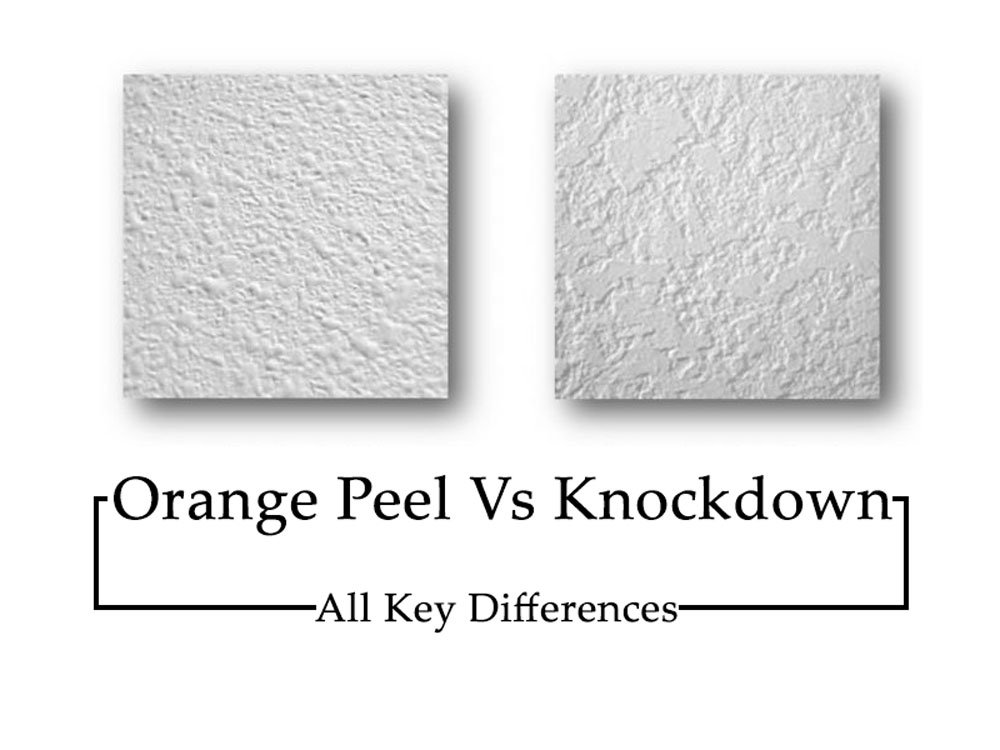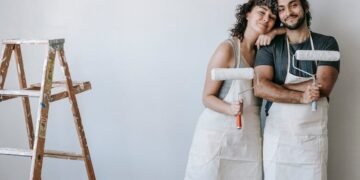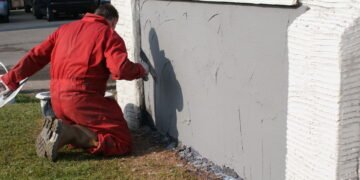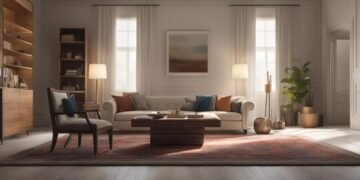Ceiling texture is a game’s name related to interior design trends in the 90s and early 2000s. The orange peel texture and the Knockdown texture are two of the most common.
But what’s the difference between orange peel and knockdown? And which one should you choose?
The main difference between the orange peel and the knockdown is that it never takes more hours to ‘knock down’ the texture to create the orange peel effect. It can be sprayed or rolled on and left to dry.
Orange peels are slightly more durable than knockdowns due to their shallow texture. But a knockdown is easy to repair without requiring special attention to ‘match’. whenever you use the same mixing process, it will look great!
Let’s look in-depth to know more about Orange Peel Vs Knockdown texture.
What is Orange Peel Texture?
Orange peel is a texturizer that sprays ovals of different sizes, usually available in a can. They are not raised enough to be annoyed when touched and create a more uniform feel and appearance than other texture types.
common constructors build new homes and use orange peel in the kitchen and bathrooms because of its cleanliness and durability in high-use areas of the house.
The orange peel texture has stood the test of time and undergoes all the different textures that came and went from the 1970s to the early 1990s. Orange peel texture is on the roofs and walls of millions of homes.
Orange peel texture adds character to surfaces and mixes properly with natural or soft colors. However, it is challenging to clean because small gaps between the ovals are almost impossible to reach.
Orange peel texture is a versatile but minimal texture that can add a warm and cheery feel to any wall and ceiling.
Orange peel texture comes in a powder form that needs to be mixed with water to get the right consistency depending on the orange peel you are going for (heavy, medium, or large) or trying to blend.
Making orange peel is easy: spray it onto the ceiling in small bursts of half a meter or so, then wait for it to dry, prime, and paint. Try ceiling texture spray on a piece of cardboard first and test to make sure you have chosen the best angle and distance.
[su_row]
PROs
[su_list icon=”icon: check” icon_color=”#04b725″]
- It can help to hide imperfections in the ceiling. If you have any cracks or stains on your roof, the orange peel texture will help disguise them.
- Orange peel texture is also easy to apply, you must spray it and let it dry.
- In terms of cleaning, orange peel wins this test because there is less change in depth-so it is easier to clean.
[/su_list][/su_row]
[su_row]
CONs
[su_list icon=”icon: remove” icon_color=”#e80811″]
- Orange peel ceiling texture can be challenging to repair if damaged. If you ever need to remove the texture, it can be a messy and time-consuming process.
[/su_list][/su_row]
What is Knockdown Texture?
Knockdown texture finishes are an early 1990s successor to orange peel textures. It has become popular with homeowners for its impressive looks and practicality.
To get such knockdown texture, you need to reduce the consistency of the joint compound by adding water. You will also need a knockdown tool to apply this mixture, but if you don’t have one, you can also use a trowel.
Spray, trowel, or roll drywall joint compound onto the wall or ceiling to achieve stalactite-like peaks, then flatten the peaks with a knockdown knife. The resulting distorted, natural texture adds dimensional visual impact and hides any surface imperfections to hand.
As a bonus, the treatment helps mute the sounds. Another part of the appeal? DIYers with basic drywall skills and some affordable tools and materials can easily create the look. It is produced by placing a plaster foundation and gently tapping over the entire surface with a soft brush or a sponge.
Knockdown texture finishes are popular in bedrooms, living rooms, and hallways. This type of texture involves spraying a coat of paint about ⅛ inch thick. High points are knocked off using a putty knife or trowel after the first coat has dried. This type of texture paint is tough and durable.
Knockdown is a more voluminous texture than orange peel. It consists of board spots of drywall mud (mixture) but is still smooth because its components have no edges.
[su_row]
PROs
[su_list icon=”icon: check” icon_color=”#04b725″]
- You can get some sound diffusion that gives all the ceiling texture. If you live in a room with hardwood floors and other hard materials, this is a great choice to add comfort.
[/su_list][/su_row]
[su_row]
CONs
[su_list icon=”icon: remove” icon_color=”#e80811″]
- Knockdown ceiling texture can be challenging to repair if damaged.
- You will need a knockdown knife to get rid of the rough surface, this texture gives, so if you don’t have one- it is an added expense.
[/su_list][/su_row]
Related Post: How to Mix Wood and White Trim for Perfect Finishing?
Key Differences Between Orange Peel and Knockdown
Even if you are aesthetically happy with orange peel and knockdown of either type, there are numerous differences in their appearance, application, durability, and difficulty of repair that may make you lean toward one over the others.
1. Appearance & Design
Orange peel
One of the biggest appeals of this finish type is its incredible versatility. It is as suitable for a sophisticated contemporary-designed room as it is for a classic, warm, and homely feeling room.
For this reason, it is a safer option than a knockdown, which is usually associated with more modern and contemporary decor.
Knockdown
As mentioned, a knockdown wall finish looks safer and even more dynamic and modern than an orange peel finish.
Although it is generally considered a ‘new’ type of finish, you should not be afraid to use it with any decor you want, as it is still versatile enough to be used in a more traditional style.
2. Application method
To create orange peel textures, a joint compound is sprayed on the surface using a specialized gun. But, in the case of knockdown texture, an additional step is required to flatten the peak after spraying the compound. For better idea, you can read the following steps for both.
Orange peel
Remove any pre-existing wallpaper, sand everything down to a nice and smooth texture, and then apply a primer of your choice to present an excellent surface for the compound to adhere to.
Next, cover the dry mix wall powder with the water indicated on the package. Doing this by hand can be tedious, so combining it with a drill will make your life much easier.
Place the mixture in the hopper gun and set it to high pressure with the small nozzle. You should practice on a spare piece of drywall first to get a feel for how the spray works.
Apply a layer of sealer/paint primer over the texture to give it extra durability and an excellent surface to adhere to your final paint finish.
Knockdown
Start preparing the wall by sanding it to a smooth texture and applying a drywall filler to ensure you have a nice, even surface to use the texture.
Next, mix your mud/drywall compound according to the packet instructions, like an orange peel drywall texture, and load it into the hopper.
Set the mixture aside for about 15 minutes to ensure the water is completely absorbed or starts to thicken in the hopper. Once your application consistency is correct, apply it to the wall.
One of the essential elements here is to wait for the right time before ‘knocking down’ the splatter. If it’s too dry, you put it back on the drywall.
An excellent general room must wait about 10 to 15 minutes after application.
Drag the knockdown knife in a straight, smooth motion to remove peaks and create impact. Once the proper finish is finished, seal it with your favorite primer to prepare for painting!
3. Durability
Orange peel
Orange peel is considered the most durable finish in the market. That is because it is textured drywall. Nothing that stretches too far can chip or be easily damaged.
Nevertheless, in the event the wall is damaged in some way, most of the time. It’s barely noticeable because a small ding or nick will blend into the style of the wall.
An orange peel finish can last indefinitely, Combined with this, it works with many decor styles making it the single most durable wall finish you can use.
Knockdown
Although not considered weak or easily damaged compared to orange peel, A knockdown finish is more susceptible to chipping and damage because it has a more exposed flat area and a larger surface area.
4. Cleaning and Maintenance
Orange peel
Generally, a textured wall requires more cleaning and maintenance than a simple, plain wall design.
Also, cleaning is more time-consuming due to the flat surface. Simply wiping the wall only gets into some of the nooks and crannies the texture creates. That means you must be extra careful and spend your spare time cleaning everything thoroughly.
Knockdown
In terms of peaks and valleys, the depth difference is more than an orange peel’s shallow effect. This means it is more susceptible to dust or dirt accumulating in crevices, requiring extra time and attention to clean thoroughly.
While both require considerable care and attention to clean, knockdowns are more time-consuming.
5. Repairing
Orange peel
Orange peel finishes have a very stylized look, and while they work great for making small items, You will rarely find yourself needing to make any simple repairs.
It can be quite a hassle if you experience some damage and need to finish some wall parts.
Most textured finishes can be removed with a scraper or trowel because they stretch enough to have something to grab onto.
Knockdown
The repair process for knockdown finishes is similar to orange peels. You will need to sand the area and reapply the finish as you did the first time.
Because of its slightly thicker texture than orange peel, a knockdown finish is easier to remove as you can remove most of the finish with a trowel and scraper.
6. Costing
A few factors determine the costing differences between these two textures such as the area, material, and labor used.
But, Being the same area, the orange peel texture costs less than the knockdown texture because the knockdown texture requires more material and labor with more time to achieve the desired finishing.
Which is Better Choice Between Orange Peel and Knockdown Texture?
Although they are both lovely wall finishes that can suit different decorating styles, some fundamental differences should be considered before choosing one.
Knockdowns are more modern and contemporary. On the other hand, orange peel is more classy. Plus Orange peel is easier to apply and requires less labor and less time.
Moreover, orange peel is a little more durable and Knockdown finishes are more challenging to clean. Also, Knockdowns are easier to repair and remove.
Also Check: Top 5 Neutral Colours for 2023 to Make Your Home More Attractive
Other Types of Wall Texture You May Try
1. Fish Texture
Fish scale wall structure, sometimes known as half-circle or half-rotating ceiling texture. Creating texture like this in your vault seems tricky, but you can always hire people to do the work for you. Just tell them you want this design, and they will install it.
This is one of those types of ceilings that grab people’s attention as soon as they walk into your room. The most common types of swirls people go for are perlite and sand swirls.
Paint the walls plain so the fish-scale ceiling texture pops out nicely.
2. Stomped Texture
A stomp texture, also known as a crow’s foot, is a type of texture that uses a pattern brush to create. It is considered a subtype of the same or stippled ceiling because it suggests that the lines are outwardly shaped like a fan or crow’s feet.
This job requires two people: one is making the pattern, and the other is applying the mud. Use a simple brush to create this pattern, and it is a good idea to cover your floor before you start the application, as this is a messy method.
You can admire the ceiling with textured walls. The wall structure can only be used as an accent.
3. Swirl Texture
Swirl ceilings are a way to texture a ceiling, similar to skip towel or stippled ceiling textures. It is a textured paint finish that can be applied to ceilings and even walls to create decorative, three-dimensional effects.
The difference between the swirl texture and others is that it relies on circular motion to create circular patterns, unlike the random shape of skip trowel ceilings.
To create it, use a brush or sponge for a rough or smooth texture. Rub it in separate equal-sized circles around the surfaces.
The swirling style arguably makes for the most visually pleasing ceiling texture and has a notch in craftsmanship. It is usually made from a mixture of joint compounds and latex paint and can be applied with a brush, roller, or sprayer.
4. Venetian Texture
Venetian plaster, AKA Italian plaster, is a plaster material composed of slaked limestone. It may contain marble dust or other natural materials. It is applied with a trowel in skinny layers giving a rich look with depth and movements.
Some of our clients prefer a matte finish, and while not a traditional look, it can be stunning in its own right in this application. After completely drying, this plaster undergoes a carbonization process and turns stone.
Conclusion
When comparing Orange Peel vs Knockdown texture, the main difference is the visual appearance and application process. The orange peel ceiling texture looks like you covered the ceiling with citrus peels and painted over it. Knockdown ceiling textures add more depth.
Both are applied the same way, except you must use a drywall knife or knockdown trowel to achieve the knockdown ceiling texture. They both are great for hiding imperfections and adding texture to your room.
Recommended Post: How to Avoid 9 Drywall Texture Problems?













